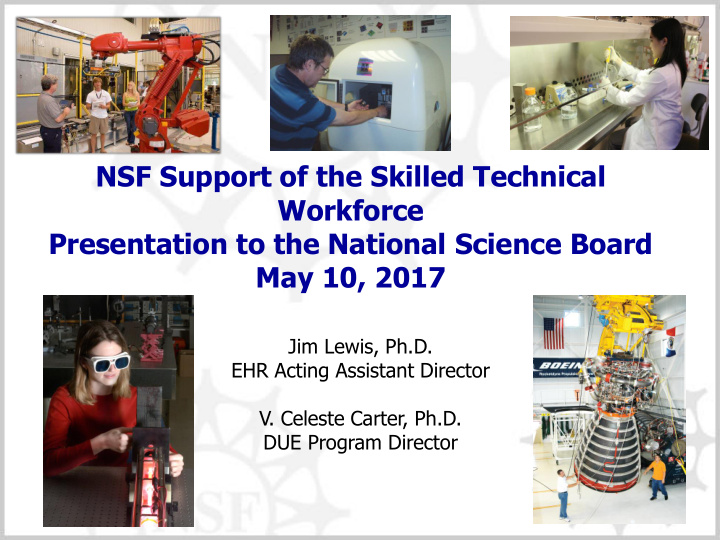



NSF Support of the Skilled Technical Workforce Presentation to the National Science Board May 10, 2017 Jim Lewis, Ph.D. EHR Acting Assistant Director V. Celeste Carter, Ph.D. DUE Program Director 1
National Academy of Science Studies DUE/ATE: 1313209 DUE/ATE: 1112988 DUE/ATE: 1406910 “Building America’s Skilled Technical Workforce” Publication date: May 18, 2017 2017 2012 2
EHR Investments Direct Student Institutional Research & Support Capacity Development NSF Scholarships in Tribal Colleges & Innovative STEM* Universities Program Technology Experiences for CyberCorps: Improving Students and Scholarships for Undergraduate STEM Teachers* Service Education Advancing Informal HSI Dear Colleague STEM Learning Letter EHR Core Research Advanced Technological Education Program * H1-B Visa Funds 3
ATE Program Budget Growth $70 $60 M $50 I L L $40 I O Cumulative Data N $30 (1994-2016) S Awarded more than • $20 $950 million Awards to 492 • $10 distinct institutions More than 65% of • $0 awards to two-year FY94 FY17 degree granting institutions. 4
American Association Community Colleges Fast Facts 2016 5 http://www.aacc.nche.edu/AboutCC/Documents/FastfactsR2.pdf
American Association Community Colleges Fast Facts 2016 Source 1. AACC membership database, January 2016. 2. NCES. (2015). IPEDS Fall 2014 Enrollment Survey [AACC analysis]. 3. AACC membership database, 2016 [AACC analysis]. 4. National Student Clearinghouse. (2015). Term Enrollment Estimates Fall 2015. 5. NCES. (2015). 2011 – 12 National Postsecondary Student Aid Study (NPSAS:12) [AACC analysis]. Files [AACC analysis]. 6 http://www.aacc.nche.edu/AboutCC/Documents/FastfactsR2.pdf
American Association Community Colleges Fast Facts 2016 7 http://www.aacc.nche.edu/AboutCC/Documents/FastfactsR2.pdf
Scientific and Advanced Technology Act of 1992 “To establish a national advanced technician training program, utilizing the resources of the Nation’s two -year associate-degree- granting colleges to expand the pool of skilled technicians in strategic advanced-technology fields, to increase the productivity of the nation’s industries, and to improve the competitiveness of the United States in international trade, and for other purposes.” 8
ATE Awards FY94-FY16 9
Advanced Technological Education (ATE) Program Associate Degree Granting Institutions Science and Engineering Technician Education Partnerships: Industry, Economic Development Agencies, Secondary schools, 4-yr Institutions Pathways: 7-12, 2- and 4-yr
11
ATE Supports Manufacturing USA Institutes PCAST recommended that the federal government convene and enable industry-led, private public partnerships focused on manufacturing innovation and engaging US universities. In 2013, President Obama launched the Advanced Manufacturing Partnership 2.0 (AMP 2.0). Interagency effort initiated to support Institutes. All funded Institutes have a workforce development plan. How many technicians support the engineers, MS, and Ph.D. scientists in industry? The Lightweight Innovation for Tomorrow (LIFT) and the Advanced • Composites (IACMII) Institutes are working with the ATE Materials Science Center. The ATE Center is developing an online learning hub and vetting all curricular resources on workforce development. 12 Additional information in NSF Dear Colleague Letter 16-007
Community College Innovation Challenge (CCIC) Who: Teams of three to five community college students, a faculty mentor, and a community or industry partner. What: Teams propose innovative, STEM- based solutions for real-world problems they identify within one of three themes for FY17: • Maker to Manufacturer • Energy and Environment • Security Technologies www.nsf.gov/CCchallenge 13
Carnevale , A., N. Smith, M. Melton, “STEM”, Report from the Center on Education and the Workforce, Georgetown University, 2011 The vast majority of STEM jobs require some form of postsecondary education or training. By 2018, roughly 35% of the STEM workforce will be composed of those with sub-baccalaureate training, including: 1 million associate degrees 745,000 certificates 760,000 industry-based certifications http://cew.Georgetown.edu/stem/ Career Pathways for STEM Technicians, Dan Hull. 2012 14
Recommend
More recommend